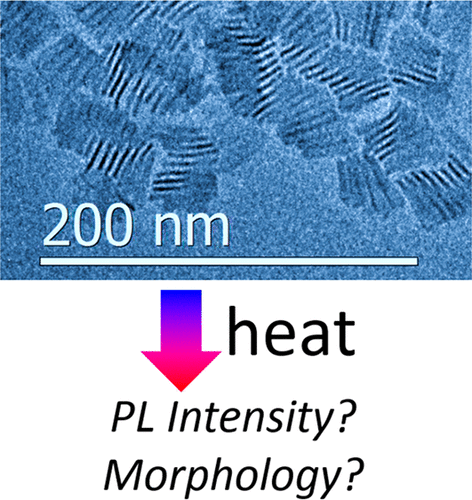当前位置:
X-MOL 学术
›
J. Phys. Chem. Lett.
›
论文详情
Our official English website, www.x-mol.net, welcomes your
feedback! (Note: you will need to create a separate account there.)
Elevated Temperature Photophysical Properties and Morphological Stability of CdSe and CdSe/CdS Nanoplatelets
The Journal of Physical Chemistry Letters ( IF 4.8 ) Pub Date : 2018-01-03 00:00:00 , DOI: 10.1021/acs.jpclett.7b02793 Clare E. Rowland 1, 2 , Igor Fedin 3 , Benjamin T. Diroll 2 , Yuzi Liu 2 , Dmitri V. Talapin 2, 3 , Richard D. Schaller 1, 2
The Journal of Physical Chemistry Letters ( IF 4.8 ) Pub Date : 2018-01-03 00:00:00 , DOI: 10.1021/acs.jpclett.7b02793 Clare E. Rowland 1, 2 , Igor Fedin 3 , Benjamin T. Diroll 2 , Yuzi Liu 2 , Dmitri V. Talapin 2, 3 , Richard D. Schaller 1, 2
Affiliation

|
Elevated temperature optoelectronic performance of semiconductor nanomaterials remains an important issue for applications. Here we examine 2D CdSe nanoplatelets (NPs) and CdS/CdSe/CdS shell/core/shell sandwich NPs at temperatures ranging from 300 to 700 K using static and transient spectroscopies as well as in situ transmission electron microscopy. NPs exhibit reversible changes in PL intensity, spectral position, and emission line width with temperature elevation up to ∼500 K, losing a factor of ∼8 to 10 in PL intensity at 400 K relative to ambient. Temperature elevation above ∼500 K yields thickness-dependent, irreversible degradation in optical properties. Electron microscopy relates stability of the core-only NP morphology up to 555 and 600 K for the four and five monolayer NPs, respectively, followed by sintering and evaporation at still higher temperatures. Reversible PL loss, based on differences in decay dynamics between time-resolved photoluminescence and transient absorption, results primarily from hole trapping in both NPs and sandwich NPs.
中文翻译:

CdSe和CdSe / CdS纳米片的高温光物理性质和形态稳定性
半导体纳米材料的高温光电性能仍然是应用中的重要问题。在这里,我们使用静态和瞬态光谱以及原位透射电子显微镜在300至700 K的温度范围内检查了二维CdSe纳米片(NPs)和CdS / CdSe / CdS壳/核/壳夹心NP。在温度升高至约500 K时,NP的PL强度,光谱位置和发射谱线宽度可逆变化,相对于环境,在400 K时PL强度损失约8到10倍。温度升高到约500 K以上,会导致厚度依赖于光学性能的不可逆退化。电子显微镜检查分别针对四个和五个单层NP的仅核心NP形态的稳定性分别高达555和600 K,然后在更高的温度下烧结和蒸发。基于时间分辨的光致发光和瞬态吸收之间的衰减动力学差异,可逆PL损耗主要是由NP和夹心NP中的空穴俘获引起的。
更新日期:2018-01-03
中文翻译:

CdSe和CdSe / CdS纳米片的高温光物理性质和形态稳定性
半导体纳米材料的高温光电性能仍然是应用中的重要问题。在这里,我们使用静态和瞬态光谱以及原位透射电子显微镜在300至700 K的温度范围内检查了二维CdSe纳米片(NPs)和CdS / CdSe / CdS壳/核/壳夹心NP。在温度升高至约500 K时,NP的PL强度,光谱位置和发射谱线宽度可逆变化,相对于环境,在400 K时PL强度损失约8到10倍。温度升高到约500 K以上,会导致厚度依赖于光学性能的不可逆退化。电子显微镜检查分别针对四个和五个单层NP的仅核心NP形态的稳定性分别高达555和600 K,然后在更高的温度下烧结和蒸发。基于时间分辨的光致发光和瞬态吸收之间的衰减动力学差异,可逆PL损耗主要是由NP和夹心NP中的空穴俘获引起的。









































 京公网安备 11010802027423号
京公网安备 11010802027423号